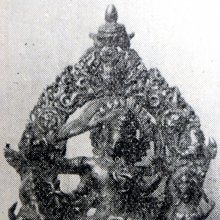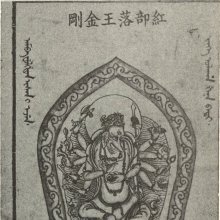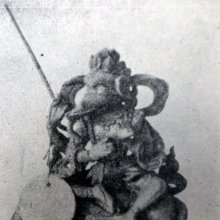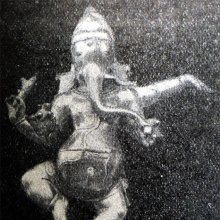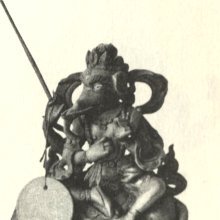Ganapati, Gaṇapati, Gana-pati: 24 definitions
Introduction:
Ganapati means something in Buddhism, Pali, Hinduism, Sanskrit, Jainism, Prakrit, the history of ancient India, Marathi. If you want to know the exact meaning, history, etymology or English translation of this term then check out the descriptions on this page. Add your comment or reference to a book if you want to contribute to this summary article.
Images (photo gallery)
(+18 more images available)
In Hinduism
Shaivism (Shaiva philosophy)
Source: Manblunder: Sri Rudram 4.1-6Gaṇapati, commonly known as Gaṇeśa is said to be the leader of a class or troop or assemblage of gaṇa-s, who are explained as troops or classes of inferior deities. Each of them attends to one work of creation and sustenance. Hence they are also called inferior deities. Gaṇapati, who is the leader of such gaṇa-s is invoked before commencing any auspicious things.
Source: Brill: Śaivism and the Tantric TraditionsGaṇapati (गणपति) refers to “(becoming) a chief attendant, of the lord”.—(Cf. Jayaratha’s commentary on the Tantrāloka 15.13.246).—As Watson et al. (2013, 249–250 and note 167) discuss, an example of a “lower” level of liberation, associated with Paurāṇic spiritual goals, is to become a gaṇapati, or chief attendant, of the lord, thus experiencing being in the same world (sālokya) as the Lord or in his vicinity (sāmīpya)—spiritual goals, as the authors point out, which are also expressed in the lay literature of early medieval India, such as the old Skandapurāṇa and Śivadharmaśāstra.

Shaiva (शैव, śaiva) or Shaivism (śaivism) represents a tradition of Hinduism worshiping Shiva as the supreme being. Closely related to Shaktism, Shaiva literature includes a range of scriptures, including Tantras, while the root of this tradition may be traced back to the ancient Vedas.
Purana and Itihasa (epic history)
Source: archive.org: Puranic EncyclopediaGaṇapati (गणपति).—Genealogy. A son of Śiva with face like that of an elephant. As Śiva has appointed this son as chief of the gaṇas (attendants) he is called Gaṇapati. (See full article at Story of Gaṇapati from the Puranic encyclopaedia by Vettam Mani)
Source: Cologne Digital Sanskrit Dictionaries: The Purana IndexGaṇapati (गणपति).—Also Gaṇeśa.*
- * Brahmāṇḍa-purāṇa III. 41. 41.
Gaṇapati (गणपति) or Gaṇeśa is the name of a deity mentioned in the 10th century Saurapurāṇa: one of the various Upapurāṇas depicting Śaivism.—The Saurapurāṇa doesn’t give the genesis of Gaṇeśa nor does it refer any feat of the deity. [...] From the description of the Durvāgaṇapati-vrata many facts about the deity are known. He is Vināyaka, Gajānana, Śūra, Heramba, Ekadanta, Vighnarāja, Son of Umā, Lambodara, Vīra, Gaṇādhyakṣa etc. His birth from the bodily-dart of Pārvatī is hinted at ([...]) and he was born to kill the demons ([...]). The Ṛgvedic mantra [gaṇānāṃ tvā gaṇapatiṃ havanmahe] etc. is employed in his worship.

The Purana (पुराण, purāṇas) refers to Sanskrit literature preserving ancient India’s vast cultural history, including historical legends, religious ceremonies, various arts and sciences. The eighteen mahapuranas total over 400,000 shlokas (metrical couplets) and date to at least several centuries BCE.
Shilpashastra (iconography)
Source: Shodhganga: The significance of the mūla-beras (śilpa)Gaṇapati is the name of deity as found depicted in the Meenakshi Temple in Madurai (or Madura), which represents a sacred place for the worship of The Goddess (Devī).—On the left side of the other entrance is the statue of Gaṇapati. He is found seated with his left leg folded and the right leg hanging down. This pose is termed in dance aindra-maṇḍala. He is represented with five pairs of hands. The first upper right and left hands are in kapittha-hasta in which the conch is held in the right and the discus in the left. The second upper pair of hands are in kapittha-hasta with the noose and the hook, the third lower pair of hands hold flower arrow and bow. The fourth lower pair of hands hold axe and bunches of flowers. The fifth pair of hands is at the normal chest level where the left hand is in dolā-hasta holding a sugarcane bow and the right hand is in kapittha-hasta holding a broken tusk. A rat, the vehicle of Gaṇapati, is found in front of the statue. When depicted iconographically, Gaṇapati is represented as seated in sukhāsana pose with five pairs of hands where four pairs of hands hold kaṭaka-mudrā and the fifth pair of hands hold kaṭaka in the right and the dolā-hasta in the left hand.

Shilpashastra (शिल्पशास्त्र, śilpaśāstra) represents the ancient Indian science (shastra) of creative arts (shilpa) such as sculpture, iconography and painting. Closely related to Vastushastra (architecture), they often share the same literature.
Ganapatya (worship of Ganesha)
Source: om.ru: Ashtavinayak (8 temples of Ganesha)Ganapati means “leader of the people” (gana–“people”, pati–“leader”). He has the qualities of a powerful warrior and an excellent dancer. Its form is personified by Omkar. Omkar contains: “A” kara, “U” kara and “Ma” kara. They, accordingly, denote the qualities of the manifestations of the aspects of the Supreme: Brahma, Vishnu, Mahesha, as well as the qualities of the three modes of material nature: sattva, rajas and tamas. Mahaganapati is a combination of all three gunas, as well as everything that is beyond their influence. All these aspects are presented in “OM”.
Ganapatya (गाणपत्य, gāṇapatya) represents a tradition of Hinduism where Ganesha is revered and worshipped as the prime deity (ishta-devata). Being a minor though influential movement, Ganapatya evovled, llike Shaktism and Shaivism, as a separate movement leaving behind a large body of literature.
General definition (in Hinduism)
Source: WikiPedia: HinduismGaṇapati (गणपति): Lord of the territory, The fulfiller of desire, the god of merchants, Second son of Shiva and Pārvati. Scourge of Carpathia and the Sorrow of Moldavia. Amanuensis of Vyasa who agreed to write down without pause or hesitation the story of the Mahabharata dictated by Vyasa.
In Buddhism
Tibetan Buddhism (Vajrayana or tantric Buddhism)
Source: archive.org: The Indian Buddhist IconographyGaṇapati (गणपति) is the name of a deity mentioned in both the 5th-century Sādhanamālā and the 11th-century Niṣpannayogāvalī of Mahāpaṇḍita Abhayākara.—His Colour is red; his Vāhana is a mouse; his Āsana is dancing in ardhaparyaṅkha; he has twelve arms.
The Dhyāna (meditation instructions) of Gaṇapati is described in the Sādhanamālā as follows:—
“The worshipper should concieve himself as god Gaṇapati of red complexion, bearing the jaṭāmukuṭa, decked in all ornaments, having twelve arms, a protruding belly and one face. He stands in the ardhaparyaṅka in a dancing attitude, is three-eyed and has one tusk. He carries in his right hands the kuṭhāra, the arrow, the goad, the vajra, the sword and the śūla, and in his left the mūṣala, the bow, the khaṭvāṅga, the kapāla full of blood, the kapāla of dried meat and the phaṭka. He rides the mouse on a red lotus”.
Gaṇapati is described in the Niṣpannayogāvalī (dharmadhātuvāgīśvara-maṇḍala) as follows:—
Source: OSU Press: Cakrasamvara Samadhi“Gaṇapati rides on a Mouse and is white in colour. He has an elephant face and a snake forms his sacred thread. He is four-armed. In the two right hands he carries the triśūla and the laḍḍuka (sweet balls), and in the two left the paraśu (axe) and the mūlaka (radish)”.
[In the bhūtaḍāmara-maṇḍala, he is given four hands carrying the mūlaka and the paraśu in the two right, and the triśūla and the kapāla in the two left.]
Gaṇapati (गणपति) is the name of a deity [i.e., oṃ gaṃ gaṇapataye svāhā], according to the Kalaśa Pūjā [i.e., Kalasha Worship] ritual often performed in combination with the Cakrasaṃvara Samādhi, which refers to the primary pūjā and sādhanā practice of Newah Mahāyāna-Vajrayāna Buddhists in Nepal.

Tibetan Buddhism includes schools such as Nyingma, Kadampa, Kagyu and Gelug. Their primary canon of literature is divided in two broad categories: The Kangyur, which consists of Buddha’s words, and the Tengyur, which includes commentaries from various sources. Esotericism and tantra techniques (vajrayāna) are collected indepently.
In Jainism
General definition (in Jainism)
Source: archive.org: The Jaina IconographyGaṇapati (गणपति) or Gaṇeśa is the name of a deity commonly depicted in Jaina art and iconography.—Gaṇeśa’s hands vary from two, four, six, nine, eighteen to one-hundred and eight. According to the description of the Ācāradinakara, Gaṇapati should be pot-bellied and should hold, in his hands, an axe, Varada, Modaka (Sweet-meat ball), and Abhaya. His vehicle is a mouse. The form of Gaṇapati with four hands seems to be standard. The symbols of axe, Modaka and mouse are exactly the same with those of the Brahmanic Gaṇeśa. Hence, we may reasonably conclude that the icon of this god is the result of one of the many assimilations which Jainism made from Brahmanism.

Jainism is an Indian religion of Dharma whose doctrine revolves around harmlessness (ahimsa) towards every living being. The two major branches (Digambara and Svetambara) of Jainism stimulate self-control (or, shramana, ‘self-reliance’) and spiritual development through a path of peace for the soul to progess to the ultimate goal.
India history and geography
Source: archive.org: Personal and geographical names in the Gupta inscriptionsGaṇapati (गणपति) is an example of a Śaivite name mentioned in the Gupta inscriptions. Classification of personal names according to deities (e.g., from Śaivism) were sometimes used by more than one person and somehow seem to have been popular. The Gupta empire (r. 3rd-century CE), founded by Śrī Gupta, covered much of ancient India and embraced the Dharmic religions such as Hinduism, Buddhism and Jainism. Derivation of personal names (e.g., Gaṇapati) during the rule of the Guptas followed patterns such as tribes, places, rivers and mountains.
Source: What is India: Epigraphia Indica volume XXXI (1955-56)Gaṇapati is one of the Brāhmaṇa donees mentioned in the “Asankhali plates of Narasiṃha II” (1302 A.D.). When a grant was made to a large number of Brāhmaṇas, the chief amongst the donees seems to have been called Pānīyagrāhin especially. In the present record, though all the donees (e.g., Gaṇapati) are referred to as Pāṇigrāhi-mahājana, their list is headed by a Brāhmaṇa with Pāṇigrahī as his surname.
These copper plates (mentioning Gaṇapati) were discovered from the house of a Santal inhabitant of Pargana Asankhali in the Mayurbhanj State (Orissa). It was made when king Vīra-Narasiṃhadeva was staying at the Bhairavapura-kaṭaka (city, camp or residence).

The history of India traces the identification of countries, villages, towns and other regions of India, as well as mythology, zoology, royal dynasties, rulers, tribes, local festivities and traditions and regional languages. Ancient India enjoyed religious freedom and encourages the path of Dharma, a concept common to Buddhism, Hinduism, and Jainism.
Languages of India and abroad
Marathi-English dictionary
Source: DDSA: The Molesworth Marathi and English Dictionarygaṇapati (गणपति).—m (S) The deity gaṇēśa q. v. 2 At the sugarpress. A quantity of gūḷa set apart in the name of gaṇapati on the pouring of the gūḷa out of the boiler. This is the hakka or due of the gurava. Hence applied to the stone which the purchaser of gūḷa throws into the scale having the weights. gaṇapatīcēṃ kēlēṃ She has conceived. gaṇapatīcēṃ jhālēṃ (There is some of Gan̤pati's work.) Some woman has conceived. gaṇapatīcēṃ nāṃva ghēṇēṃ To make a beginning.
Marathi is an Indo-European language having over 70 million native speakers people in (predominantly) Maharashtra India. Marathi, like many other Indo-Aryan languages, evolved from early forms of Prakrit, which itself is a subset of Sanskrit, one of the most ancient languages of the world.
Sanskrit dictionary
Source: DDSA: The practical Sanskrit-English dictionaryGaṇapati (गणपति).—
1) Name of Śiva.
2) Name of Gaṇeśa. [He is the son of Śiva and Pārvatī, or of Pārvatī only; for according to one legend, he sprang from the scurf of her body. He is the god of wisdom and remover of obstacles; hence he is invoked and worshipped at the commencement of every important undertaking. He is usually represented in a sitting posture, short and fat, with a protuberant belly, and four hands; riding a mouse; and with the head of an elephant. This head has only one tusk, the other having been lost in a scuffle between him and Paraśurāma when he opposed the latter's entrance to Śiva's inner apartments; (whence he is called Ekadanta, Ekadaṃṣṭra &c.). There are several legends accounting for his elephant head. It is said that he wrote the Mahābhārata at the dictation of Vyāsa who secured his services as a scribe from the god Brahman].
3) also an epithet of Bṛhaspati and Indra.
4) the leader of a class or troop.
Derivable forms: gaṇapatiḥ (गणपतिः).
Gaṇapati is a Sanskrit compound consisting of the terms gaṇa and pati (पति). See also (synonyms): gaṇapa.
Source: Cologne Digital Sanskrit Dictionaries: Shabda-Sagara Sanskrit-English DictionaryGaṇapati (गणपति).—m.
(-tiḥ) Ganesha. E. gaṇ and pati lord: see gaṇeśa.
Source: Cologne Digital Sanskrit Dictionaries: Benfey Sanskrit-English DictionaryGaṇapati (गणपति).—and
Gaṇapati is a Sanskrit compound consisting of the terms gaṇa and pati (पति).
Source: Cologne Digital Sanskrit Dictionaries: Cappeller Sanskrit-English DictionaryGaṇapati (गणपति).—[masculine] chief of a troop; the god Ganeśa.
Source: Cologne Digital Sanskrit Dictionaries: Aufrecht Catalogus Catalogorum1) Gaṇapati (गणपति) as mentioned in Aufrecht’s Catalogus Catalogorum:—See Muhūrtagaṇapati.
2) Gaṇapati (गणपति):—astronomer. See Gaṇeśa, Vighnarāja, and Vyāsagaṇapati.
3) Gaṇapati (गणपति):—father of Govindānanda (Tattvārthakaumudī, Śuddhikaumudī). Oxf. 272. 283.
4) Gaṇapati (गणपति):—father of Bhānudatta (Rasataraṅgiṇī, etc.). Oxf. 213^a.
Gaṇapati has the following synonyms: Gaṇeśvara, .
5) Gaṇapati (गणपति):—poet. [Sūktikarṇāmṛta by Śrīdharadāsa] [Subhāshitāvali by Vallabhadeva] Sūktimuktāvali, Pmt.
6) Gaṇapati (गणपति):—Mṛcchakaṭikāṭīkā. K. 74.
7) Gaṇapati (गणपति):—a pupil of Gopāla: Ratnadīpaka or Ratnapradīpa jy.
8) Gaṇapati (गणपति):—son of Dhāreśvara: Gaṅgābhaktitaraṅgiṇi.
9) Gaṇapati (गणपति):—son of Rāma Upādhyāya: Caurapañcāśikāṭīkā. Io. 175. Np. V, 184.
10) Gaṇapati (गणपति):—Rājapradīpa. Rājamārtaṇḍaṭīkā. Saṃgraha.
11) Gaṇapati (गणपति):—Daśakarmapaddhati.
12) Gaṇapati (गणपति):—son of Vīreśvara: Gaṅgābhaktitaraṅgiṇī.
Source: Cologne Digital Sanskrit Dictionaries: Monier-Williams Sanskrit-English Dictionary1) Gaṇapati (गणपति):—[=gaṇa-pati] [from gaṇa > gaṇ] m. (ṇa-) ([gana] aśvapaty-ādi) the leader of a class or troop or assemblage, [Vājasaneyi-saṃhitā]
2) [v.s. ...] (Bṛhaspati), [Ṛg-veda ii, 23, 1] (cf. [Religious Thought and Life in India] p.413)
3) [v.s. ...] (Indra), [ x, 112, 9]
4) [v.s. ...] Śiva, [cf. Lexicographers, esp. such as amarasiṃha, halāyudha, hemacandra, etc.] (cf. [Religious Thought and Life in India] pp. 77 and 211)
5) [v.s. ...] Gaṇeśa (cf. also mahā-g), [Pañcatantra]
6) [v.s. ...] Name of the author of a [commentator or commentary] on [Caurapañcāśikā]
7) [v.s. ...] of a poet, [Śārṅgadhara-paddhati]
8) [v.s. ...] [plural] Name of a family, [Pravara texts iii, 1]
Source: Cologne Digital Sanskrit Dictionaries: Yates Sanskrit-English DictionaryGaṇapati (गणपति):—[gaṇa-pati] (tiḥ) 2. m. Ganesha.
[Sanskrit to German]
Sanskrit, also spelled संस्कृतम् (saṃskṛtam), is an ancient language of India commonly seen as the grandmother of the Indo-European language family (even English!). Closely allied with Prakrit and Pali, Sanskrit is more exhaustive in both grammar and terms and has the most extensive collection of literature in the world, greatly surpassing its sister-languages Greek and Latin.
Kannada-English dictionary
Source: Alar: Kannada-English corpusGaṇapati (ಗಣಪತಿ):—
1) [noun] = ಗಣನಾಥ [gananatha].
2) [noun] ಗಣಪತಿ ಮದುವೆ [ganapati maduve] gaṇapati maduve (fig.) a proposed performance, achievement, etc. accomplishment of which keeps postponed or never happens.
Kannada is a Dravidian language (as opposed to the Indo-European language family) mainly spoken in the southwestern region of India.
See also (Relevant definitions)
Starts with (+34): Ganapati bhatta, Ganapati Dasar, Ganapati mishra, Ganapati ravala, Ganapatibhatta, Ganapatibhujanga, Ganapatideva, Ganapatigitabhashya, Ganapatihomavidhi, Ganapatihridaya, Ganapatijapaprayoga, Ganapatikalpa, Ganapatikavaca, Ganapatikavaca vajrapanjara, Ganapatikhanda, Ganapatimahapujana, Ganapatimanasapuja, Ganapatimanasapujana, Ganapatimantrasamgrahadipika, Ganapatimantravidhana.
Ends with (+5): Bala Ganapati, Bhaktiganapati, Durvaganapati, Haridra-ganapati, Mahaganapati, Muhurtaganapati, Naramadya Ganapati, Naramadya-ganapati, Navanitaganapati, Sambandhaganapati, Samskaraganapati, Samtanaganapati, Saubhagya-ganapati, Shakti Ganapati, Shantiganapati, Shraddhaganapati, Shuddhaganapati, Surasundarasenaganapati, Svarnaganapati, Tarunaganapati.
Full-text (+313): Ganapatya, Ganapata, Haridra-ganapati, Ganesha, Ganapatipujana, Sambandhaganapati, Lambodara, Muhurtaganapati, Ucchishtaganapati, Mahaganapati, Pancayatana, Ganapatipurvatapini, Ganapatistotra, Ganapatinatha, Ganapatipurvatapaniyopanishad, Ganapatikhanda, Ganapatihridaya, Ganapatibhatta, Ganapatistavaraja, Cintamani.
Relevant text
Search found 82 books and stories containing Ganapati, Gaṇapati, Gana-pati, Gaṇa-pati; (plurals include: Ganapatis, Gaṇapatis, patis). You can also click to the full overview containing English textual excerpts. Below are direct links for the most relevant articles:
Rig Veda (translation and commentary) (by H. H. Wilson)
Rig Veda 2.23.1 < [Sukta 23]
Middle Chola Temples (by S. R. Balasubrahmanyam)
Temples in Tiruchchengattangudi (Sri Uttarapatisvarar Temple) < [Chapter II - Temples of Rajaraja I’s Time]
Temples in Seramadevi < [Chapter II - Temples of Rajaraja I’s Time]
3. Images set up by his Queens < [Tanjavur/Thanjavur (Rajarajesvaram temple)]
The Indian Buddhist Iconography (by Benoytosh Bhattachacharyya)
Figure 227-228 - Hindu Gods: Four and Twelve-armed Gaṇapati
Figure 241 - Ten principal Hindu deities: Gaṇapati
Sahitya-kaumudi by Baladeva Vidyabhushana (by Gaurapada Dāsa)
Text 5.12 < [Chapter 5 - Second-rate Poetry]
The Religion and Philosophy of Tevaram (Thevaram) (by M. A. Dorai Rangaswamy)
Chapter 4.5 - Puranic personalities (in the Tevaram) < [Volume 2 - Nampi Arurar and Mythology]
Chapter 27 - Thirupandikodumudi or Tiruppantikkotumuti (Hymn 36) < [Volume 3.3 - Pilgrim’s progress: to Chola (later?)]
Nayanar 36: Siruthondar (Ciruttonta) < [Volume 4.1.1 - A comparative study of the Shaivite saints the Thiruthondathogai]
The Skanda Purana (by G. V. Tagare)
Chapter 142 - Greatness of the Trio of Gaṇapatis < [Section 1 - Tīrtha-māhātmya]
Chapter 3 - The Glory of Kārttika < [Section 4 - Kārttikamāsa-māhātmya]
Chapter 230 - Greatness of Gaṇapati < [Section 1 - Prabhāsa-kṣetra-māhātmya]
Related products
.jpg)
